How To Make Oboe Reeds
Learning how to brand oboe reeds is an heady step for the developing oboist. It is also one of the hardest things to master, and involves a swell deal of persistence.
Reed-making starts out equally a science, post-obit each step similar a recipe for bread. The more than experienced you become, it turns into an art. You showtime to make it your own "recipe" - you acquire to make adjustments that fit y'all as a player.
This is why you lot find conflicting information on how to make a reed - at that place are many dissimilar factors that can impact the personalization of reed-making way and practice. What you find on the internet are all of the unlike opinions of what works best for that particular oboist.
In fact, the oboists in the videos that I link in this commodity practise things a bit differently than I exercise myself. The cardinal is to keep variables consistent as you hone this craft.
Don't get me wrong, there is definitely a wrong way to make a reed. In that location are certain steps and measurements that cannot exist inverse, because the integrity of the reed will and so suffer.
For example, do not use the WikiHow article on how to make a reed. There are so many errors in the data presented, and would not brand a working reed. The internet is full of many other resource that are authentic, and much more than helpful.
As a beginner, it is extremely of import to follow each measurement and step exactly how you are taught. Ideally, you should start reed-making with someone that knows how to make reeds. Think of this like an apprentice position - you are trying to gain the wisdom and noesis from this experienced professional.
The reason I stress starting reed-making with someone else is primarily for rubber. You lot will be working with sharp and potentially dangerous tools. Learning how to work with them in a controlled and rubber style is imperative.
I would even recommend having bandaids nearby while you are making reeds. In my five years of reed-making, I have only cut myself once. I learned how to exercise things safely, which is why I haven't had more slip-ups while working on reeds.
Lastly, before the steps to making an oboe reed: be prepared to make 1000 bad reeds before they are good. Information technology takes a long time to build upward your technique and consistency. Exist patient with yourself. Reed making is a lot similar whatsoever other skill - in club to become improve, you have to practise, exercise, exercise.
Steps To Make an Oboe Reed
Before you starting time making a reed, you need the right materials. Look at my Beginner Oboe Reed Making Kit article to brand sure y'all accept all of the necessities.
As a beginner, I would recommend starting with pikestaff that is already shaped for you. Yous have all of the tools to go from shaped cane, which looks similar this.
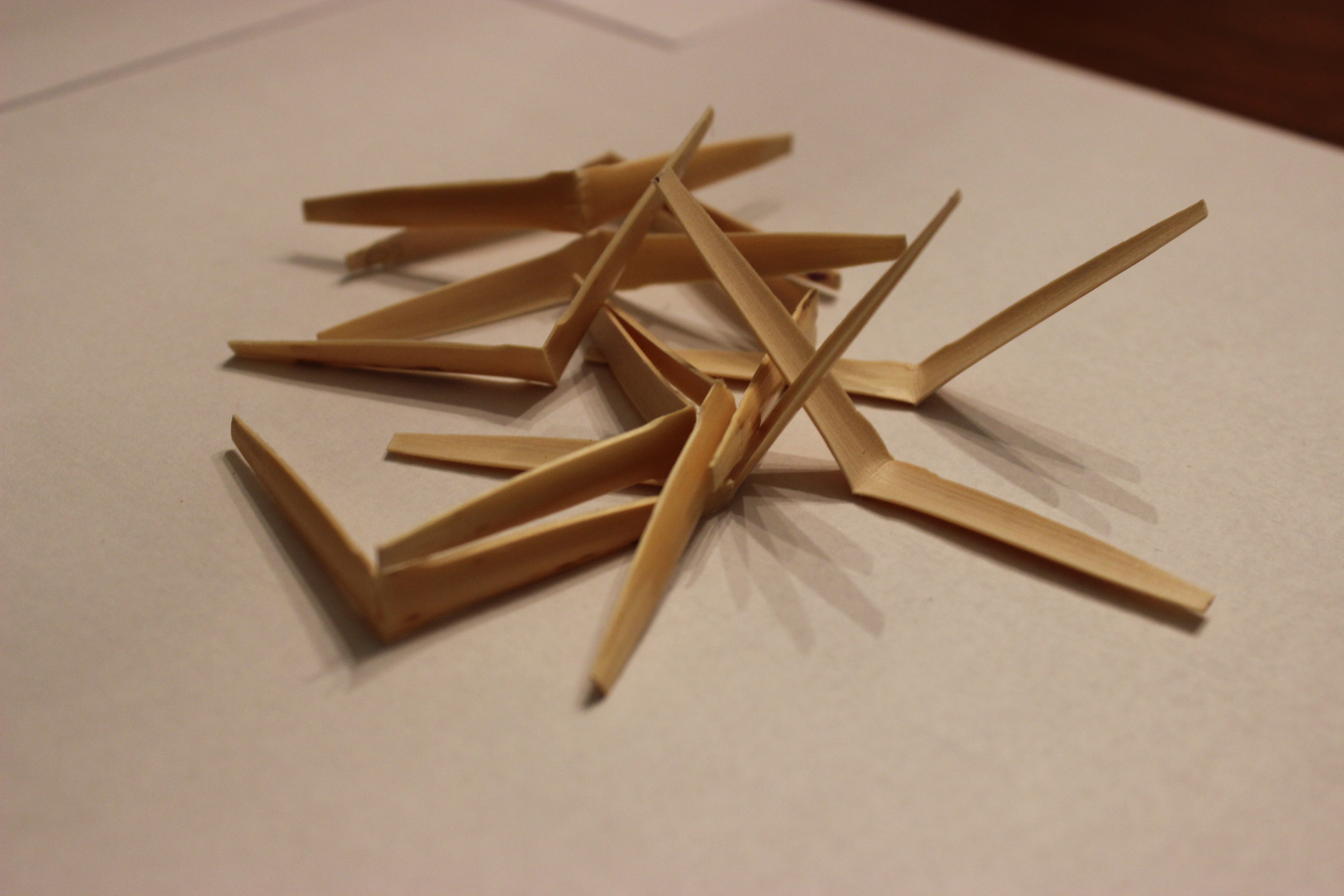
Personally, I use 10-10.5 Brannen-10 Shaped Pikestaff.
10-x.v refers to the diameter of the pikestaff. Certain diameters work meliorate for sure climates, then for me in the Midwest Usa I use x-10.5. Beyond that, I would recommend getting the least expensive cane every bit a beginner - yous will ruin plenty of pieces of cane before you make a solid reed.
1. Necktie a reed blank
First, soak shaped cane for thirty minutes in warm to hot water. Make certain that the cane is fully submerged in the water during this time then that the cane soaks completely. I normally use a larger Tupperware container for this process.
One time the cane is soaked, you should fix the rest of your station for the tying process. Take your thread and necktie to a stable surface - I often use a leg of a table for this process. Many oboists use a c-clamp to tie onto, and would highly recommend this myself. This is an particular that I will be purchasing myself in the near time to come!
I apply some beeswax on the thread to help solidify the knots that I put in. The thread has to be extremely secure, because y'all don't desire the thread to skid off the tabular array while you are tying a reed.
Sit directly in front end of the leg of the table, sitting perpendicularly nigh a human foot away. Pull the spool of thread towards you, and use the beeswax to coat nigh eight inches of the thread. To coat the thread with beeswax, run the cake all around the thread.
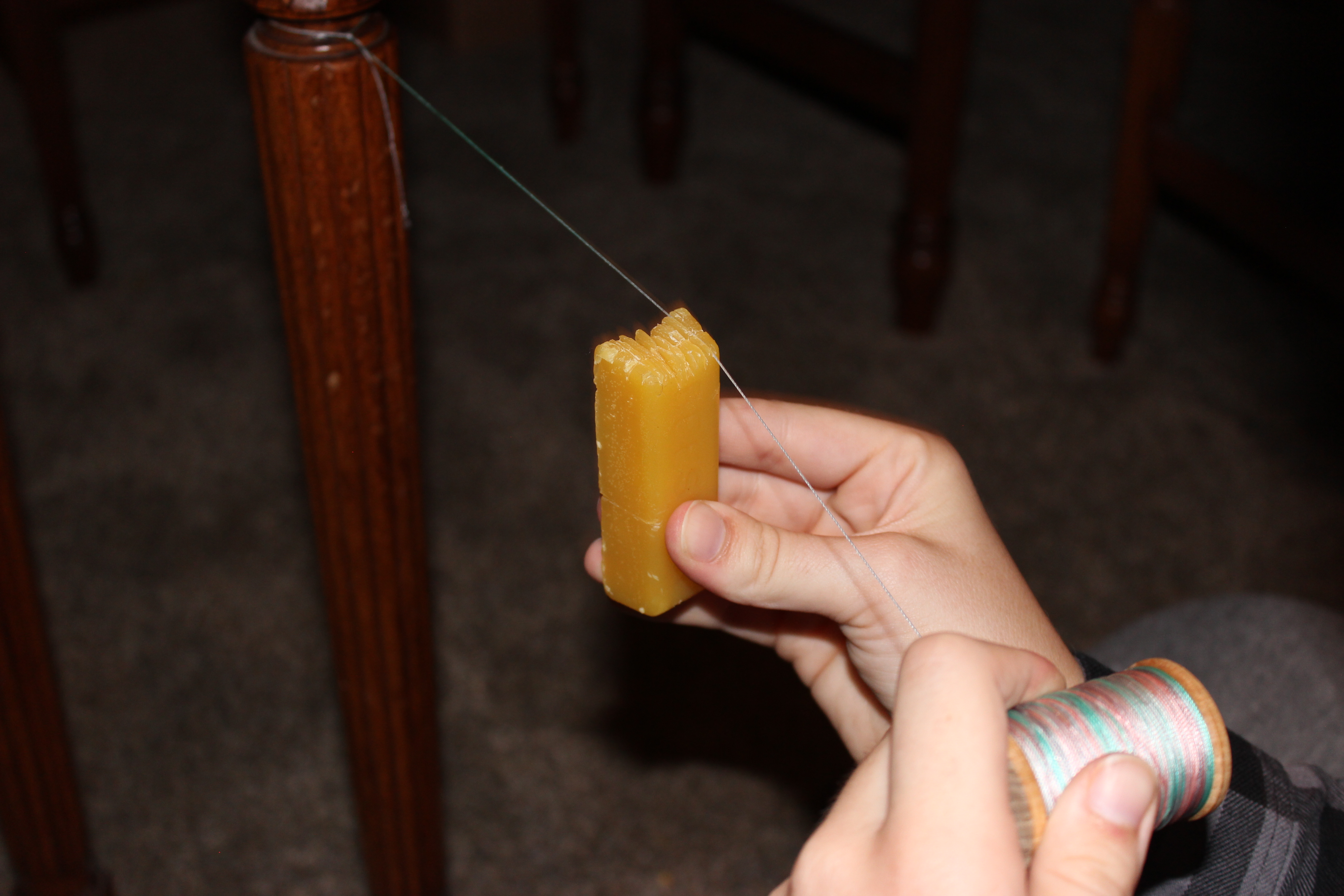
Equally you pull the thread towards you, try creating a lot of tension. Is the thread going to withstand the tension of tying a reed? If you pluck the thread, information technology should exist able to make a sound - that is how you know there is enough tension to effectively seal a reed.
Put a staple on your mandrel and take out a piece of pikestaff. Place the slice of cane over the staple - you will need your ruler to measure the length of the staple and cane.
The piece of pikestaff should line up with the flat surface on the mandrel. It should marshal with the oval shape of the tip of the staple, so that the reed itself will be every bit flat equally possible.
The cane is then slipped slightly to the right, which is what's chosen an overlap. This means that what will eventually exist the two split blades of cane won't prevarication straight on top of one another, they will in fact form a tighter seal with them e'er so slightly off-set from each other. The goal of the overlap is to strengthen the reed, meliorate the performance, and assistance to seal the reed.
Some people choose to set the overlap later on in the reed-making process when they clip open the reed. Y'all will find that in ane of the videos I link later in this article.
From the lesser of the staple to the top of the cane, it should measure out 72-73 millimeters. Information technology is important to go on it at this length throughout the entire tie-on process.
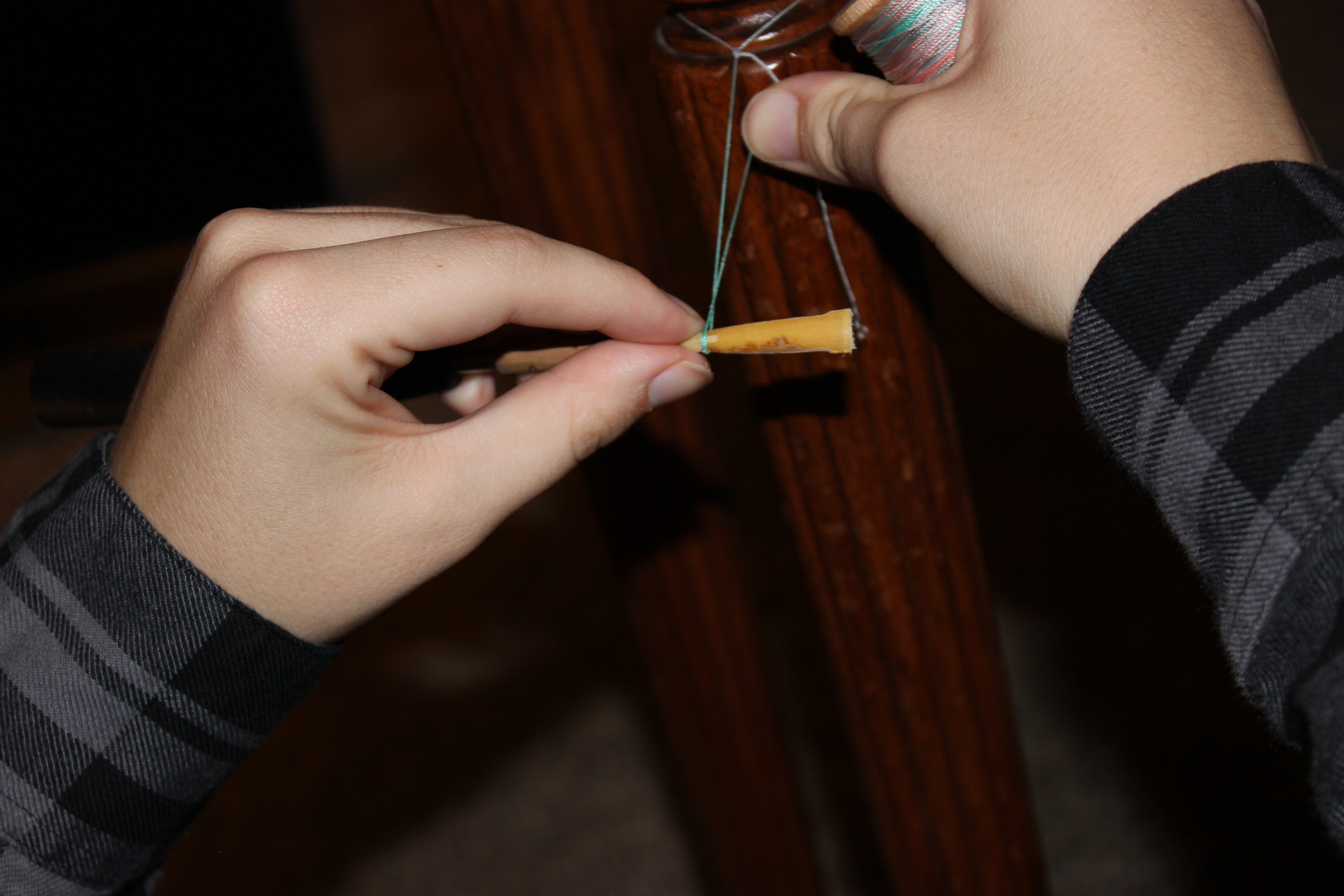
I measure from the ten mm marking on my ruler because I know that information technology is more accurate.
Concur these materials in your non-dominant hand, and take the thread in your dominant hand. Place the staple over the thread, with the thread a few millimeters below the end of the staple.
Take the thread and wrap it around the construction three times towards the cane. During this time, the cane should seal, which ways you can't run across through the sides or be able to accident air through information technology. If either of those things happen, you need to adjust so that the pikestaff seals.
Once the pikestaff seals correctly, afterwards your third wrap you are going to create the crossover of the reed.
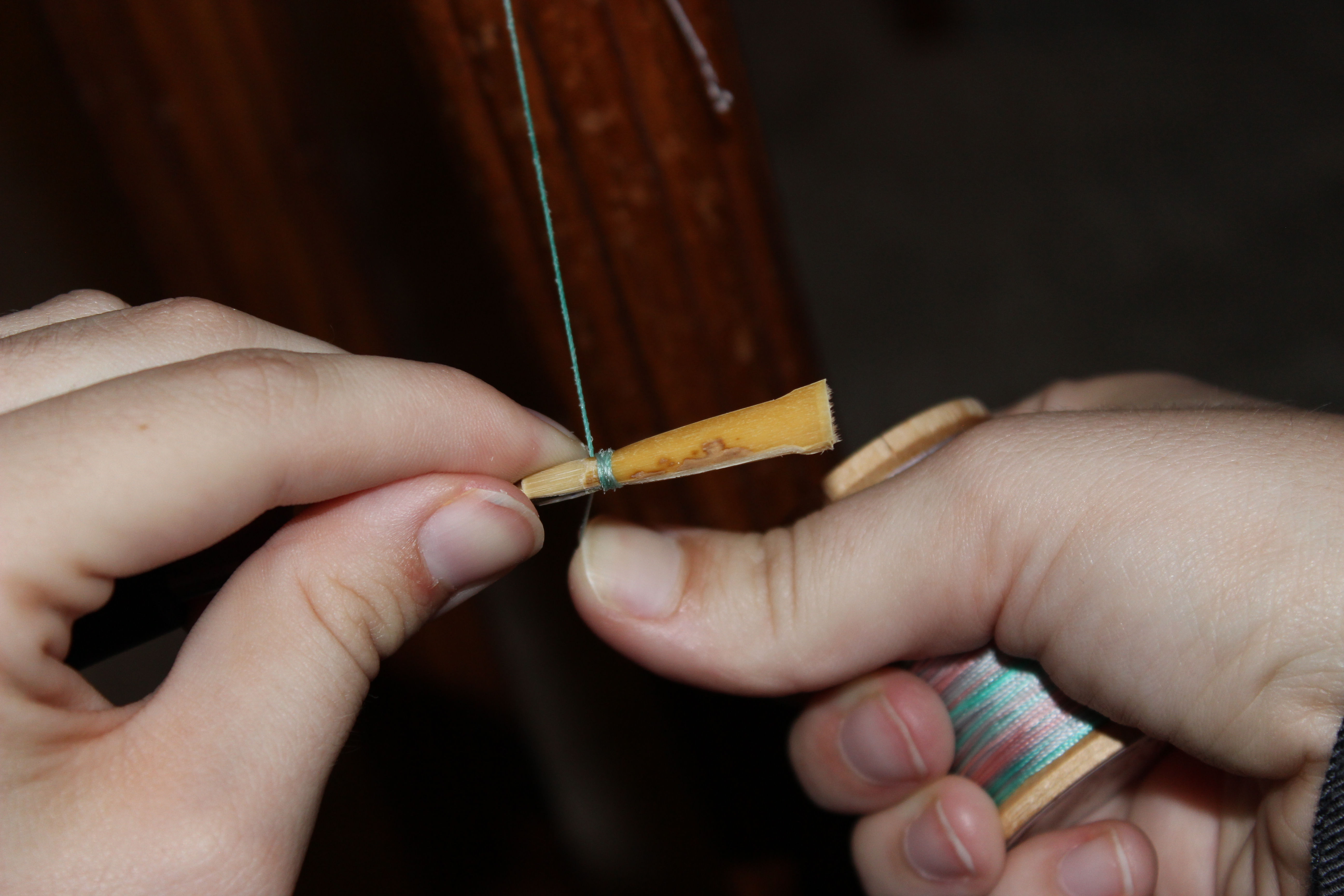
From the end of the staple to the top of the thread, it should be at or slightly under 47 mm. Practice not go over 47 mm though, because that will cause problems later on in the reed-making process.
Create the crossover past crossing your ascendant manus towards your non-dominant creating a diagonal line over the 3 wraps. Slip the thread underneath to start wrapping towards the cork function of your staple.
In this step, it's important to remember keeping tension the entire time, and that every wrap of the thread needs to lay perfectly next to the previous one, to ensure no air leaks, also as equal tension throughout.
Tie a knot at the end by making a backward check mark if yous are correct-handed - your palm should be facing you. Accept the thread on the back of your pointer finger and thumb, and hold the excess thread with the other three fingers like this.
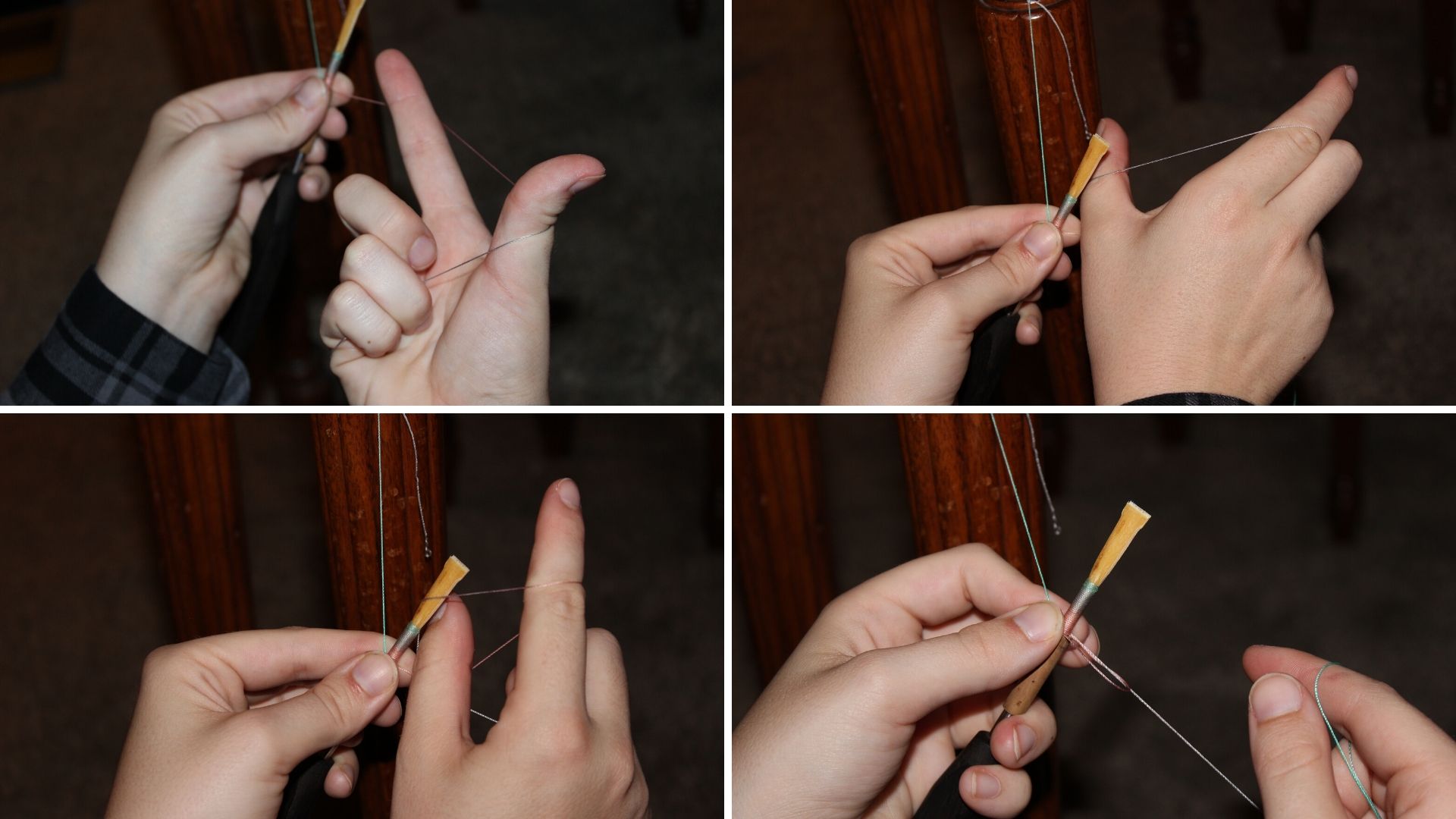
Subsequently that, while nevertheless holding the thread exactly as described higher up, flip over your mitt so that your palm is facing away from yourself. Skid the reed in the eye of the circle you have created, and guide the thread down to the beginning of the cork.
Tighten your knot on the metal part right before the cork. Repeat this knot 3 times to make certain that your thread is secure.
Once your knots are tied, you lot tin cutting off the excess thread with your knife or razor blade. Yous should at present have an oboe blank that looks something like this.
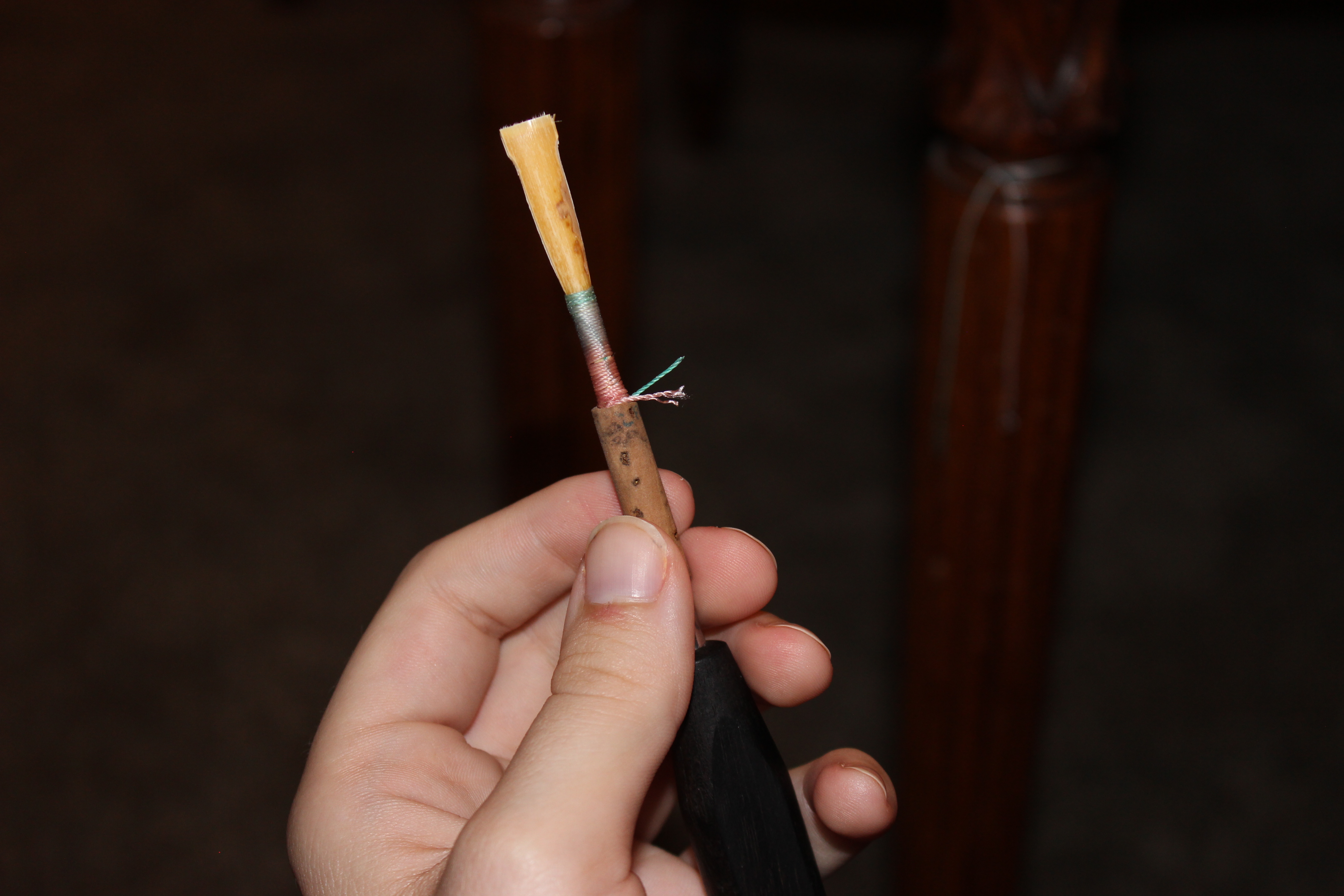
Similar most of the reed-making process, information technology is much more helpful to watch someone actually doing it. A good video to lookout someone tie on a reed by Oboe Files.
Next, remove the ears of the reed. You volition notice in the picture higher up, the tip of the reed of a sudden jutts outwards. Make clean upwards the edges to make the tip line up with the residue of the reed.
Do this by holding the reed still on the mandrel in your non-dominant hand. Then place the thumb on your dominant mitt at the tip of the reed. Have the knife an gently guide it towards your thumb, taking off the excess cane at the side of the reed.
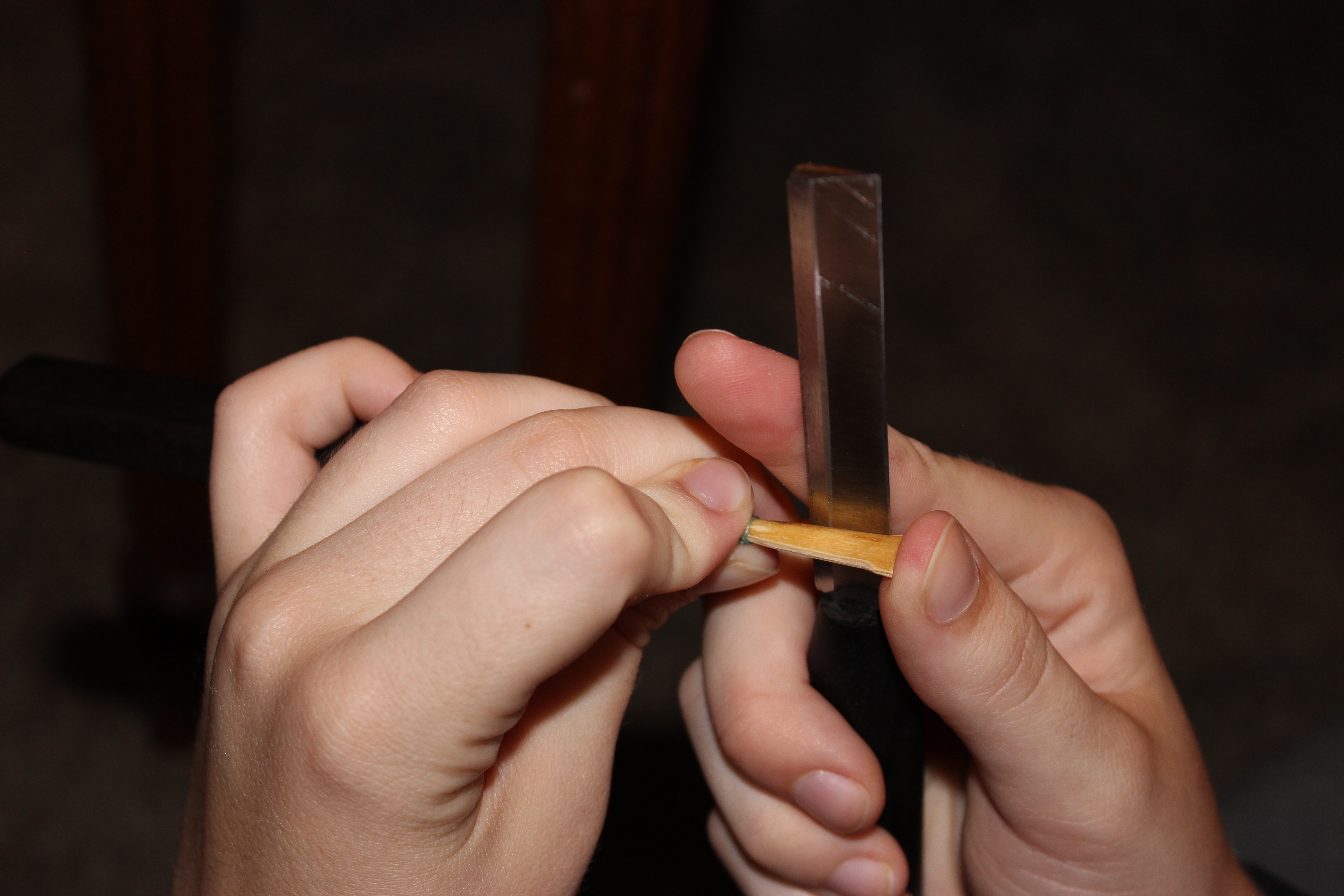
After I am done with the tie-on process, I take off the bawl from the tip of the reed before I let the blank sit for a day to dry out out. I do this and so that information technology makes a sort of upside-downwards 'v'.
When taking the bark off the tip, outset with small strokes. You are just dusting the superlative layer of pikestaff off the border.
The key to scraping a reed is keeping consequent with the force per unit area and never stopping at whatsoever given betoken. Long strokes that go on off the end of the tip avoids any ledges or unevenness in the cane.
ii. Remove bark
The side by side solar day brings the next phase of reed-making: taking off the bark. To start this process, soak the reed blank for 10 minutes in hot water. The reason it is called a reed blank is that there hasn't been any scraping done on it yet.
Here is an prototype of the "anatomy of a reed." This will assistance you to understand what part of the reed I am talking about.
When I remove the bark, I like to keep track of the number of strokes I brand with the pocketknife.
For instance, I get-go scrape on the upper left of the pikestaff for six strokes, and so the upper correct for six, then I flip it over to repeat. Past keeping the number of strokes uniform, the reed will stay close to symmetrical which is important for balancing the vibrations.
After a few sets of that, I like to remove the bawl of the back and some of the rail past using long strokes. This is dissimilar from the strokes you were using for the tip of the reed.
Do no more than half-dozen strokes on either side. The cane that you are removing at this betoken in time should exist focused on the tip. The other parts of the reed will exist scraped more than in the balancing process.
It is even more than important to go on the knife moving over the acme layer of cane at this indicate in fourth dimension. For now, it is really important to protect the spine of the reed.
Endeavor not to take besides much pikestaff out of the center of the reed. This is the office that keeps the opening of the reed open up and provides structure.
Here is another youtube video past Oboe Files that walks you through the first day of scraping.
iii. Sparse Tip
Afterward the initial scraping of the reed higher up, go back to thinning the tip. When in uncertainty, thin the tip. One time you get to a bespeak where you think the tip is sparse plenty, scrape some more than.
While working on the tip, you volition probably run into a lot of problems. You will lose corners, scrape off also much, or make the tip ragged or frayed. As you develop your knife skills, you volition start to do these things less and less. Don't be also harsh on yourself though. Later on five years of reed-making experience, I still run into these problems.
While working with the tip of the reed, you need to be very gentle. It is like y'all are brushing off atoms of cane. You are gradually making the reed weaker as you have cane off, which will brand it possible for the reed to vibrate freely.
The tip of a reed is thinner than a human hair, so it volition get to a betoken where scraping on the tip is uncomfortable - you may feel nervous that you lot will ruin the tip. That's how you know it is time to motility onto the next stage of reed making.
iv. Clip the reed open up
You'll observe that the tip of the reed blank is closed, and doesn't have the two separate blades of pikestaff like a normal reed. After this footstep is done, you will have the 2 separate blades of cane.
Once the tip of the reed is sparse like mentioned above, it'south now time to clip open the tip of the reed. Y'all know that it's time to clip the reed open up when information technology is so weak that you want to put a plaque in it.
Have your cutting block and a razor bract. Place the reed on the cutting cake, and cut off the smallest amount of cane at the tip. Y'all want to take simply enough off to open up up the tip of the reed.
5. Establish Heart
In this phase of reed-making, yous are creating the base of your sound - the heart. The cane needs to be thick plenty to support a rich sound, but thin plenty to let vibrations flow through it.
One of the near important parts of reed-making makes an appearance at this stage - the crow. Crowing the reed shows the bare bones of what a reed is without the impact of any embouchure.
You place your mouth up to the thread of the reed and accident. This creates a sound that, much similar it's name suggests, sounds like a crow.
You want to be able to hear a C (the pitch) when you accident lightly, and then every bit you increase the air speed a C an octave lower appears. The high C happens in the tip of the reed, whereas the lower C happens in the heart. The heart provides the support needed to allow for the lower C to appear in the crow.
This phase of reed-making is the hardest to understand without seeing a teacher do it. Learning how to respond to the mode an individual piece of cane is reacting takes lots of practice and messing up.
Exercise your best to protect the spine throughout this process. The center of the heart is the thickest function, with the reed sloping down as you move out towards the edges.
Oboe Files has one more video focusing on the 2nd day of scraping, which is helpful for both this phase and the next one.
After this stage is done, I would gear up the reed bated to relax and take it's new shape. When you return to the reed the next day, it will have settled which is prime time to terminate the reed.
vi. Balancing and Finishing
At present that you take a reed that vibrates, the task becomes making the reed both comfortable to play and one that sounds expert. Priorities to keep in mind for the finishing/balancing process is every bit follows (in this social club): response, pitch, and tone quality.
Response ways that the reed feels easy to play on - the vibrations should move freely. You shouldn't feel like y'all are blowing too hard to make a sound. When you play the reed, it should exist able to make sound without you lot even having to clear.
The pitch refers to both the crow and how it plays on your musical instrument without having to baby it or put actress effort into bringing it to pitch. The crow should sit at a solid 'c.'
The least important part of this process every bit a beginner is focusing on the tone quality of the reed. This is the office where yous need to actually put the reed in your oboe and scrape in specific places to achieve your desired event. Similar all of reed making, this takes practice, fourth dimension, and feel to exist able to place what a particular reed needs.
An example of a specific identify to scrape is for the darkness or warmth of a reed. These things often come up from taking more cane out of the back.
That is just 1 example, but at that place are many other very specific places that you can expect at while finishing a reed. Here is a great video outlining some of the aspects of finishing a reed, presented by performer and educator Jennet Ingle.
Here are some things to keep in mind while you are finishing the reed. Taking cane off of the tip lowers pitch, only allows the reed to vibrate more freely.
The biggest aspect of this phase of reed making is thinning the tip and and then clipping it. Thin and clip. Thin and clip.
Clipping the tip brings the pitch upwards, just makes the reed less responsive. In other words, before you determine to prune the tip, make sure that the reed is overly responsive.
In guild to make the reed more than responsive, sparse the tip!
Reeds can exist really open when they are make new. Don't exist afraid to pinch down a well soaked reed to make the tip opening more manageable. This volition assistance to brand the reed less wild and bring the pitch up.
At that place are many more things that you volition meet while reed-making, but those are some of the bones principles of finishing a reed.
Concluding Thoughts
In general, reed making involves a lot of trial and error. The goal is to gain experience. Go sleuthing on youtube for reed making tips, go to camps that involve reed making, attempt to get in contact with an experienced reed-maker, and/or find a friend to make reeds with. Reed-making tin feel similar a very isolated activity, just it involves a lot of conversations with other reed-makers.
Reed-makers are like scientists. They try out a bunch of different methods to run into what makes the best reed for them. This can change over time, if yous move to a new place, when the season changes, etc.
I would recommend keeping a reed journal for this very reason. Go on rail of the dissimilar things you are doing. What type of materials did you use, like specific cane or staples? When did you make the reeds? What exact measurements did you lot use? Any specific observations to make note of? etc.
It is piece of cake to go emotionally fastened to this glorified piece of dried grass that you have given then much time to. When a reed is not a success in terms of playability, reframe your mind to focus on what that particular reed taught you.
You learn more about the process each time y'all make a reed, and y'all get additional practise on those incredibly fine motor skills involved with scraping cane.
Eventually you will proceeds experience and pick up some stories along the style. Enjoy learning well-nigh this new side of the oboe, and have fun honing this craft.
I learn something new every time I sit down downwards to make a reed or talk about reeds with another oboist. Exist patient, and call back - a reed is just an inanimate object.
Source: https://www.notestem.com/blog/how-to-make-oboe-reeds/
Posted by: brannanuncy1967.blogspot.com


0 Response to "How To Make Oboe Reeds"
Post a Comment